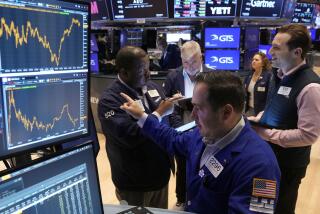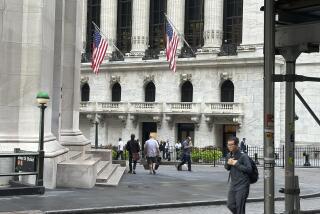116-Point Swing in Dow’s Wildest Day : Stock Market Dives 44.15 as Volume Reaches Record 302.39 Million Shares
- Share via
NEW YORK — Like a rocket careening out of control, the stock market on Friday staged its wildest day in history, soaring higher than ever before, falling faster and breaking its previous record in trading volume--set just over a week ago--by almost 50 million shares.
The Dow Jones industrial average closed at 2,101.52 points, down 44.15 for the day, but those figures do not begin to describe the unprecedented waves of panic buying and selling that rocked the market.
At one point in the day, the Dow index fell a nerve-jangling 116.71 points in 71 minutes--moving from a record gain of 64.68 points over Thursday’s close to a loss of 52.03 between 1:39 p.m. and 2:50 p.m.
Within minutes, however, the Dow had surged back into the plus column, only to reverse field a third time and head into negative territory.
‘You Just Freeze’
Traders throughout the financial community could scarcely comprehend the market’s behavior. “It was so far beyond the realm of what you’re used to seeing that you just freeze,” said Robert Cain, a trader for the New York investment firm of Twenty-First Securities. “You just don’t know how to trade it.”
Volume on the New York Stock Exchange was 302.39 million shares, exceeding the previous record of 253.1 million shares, set Jan. 15, by 49.29 million shares, or nearly 20%. By most accounts, however, the NYSE’s highly computerized system handled the unprecedented flow of orders without incident.
Instead, it was the exchange’s human work force that suffered the strain. After the market closed, traders described how wave after wave of high-volume orders had rolled onto the floor almost without respite.
“I never looked up,” said Robert Jacobson Jr., a specialist trader--that is, one responsible for maintaining orderly trading in several stocks. “I’m spent. At the end I felt like I was in the closing seconds of a hockey game, just watching the clock for it to be over.”
Securities professionals were examining Friday’s trading closely to determine if the unprecedented surge and hairpin reversal were signs that the market’s remarkable 1987 rally is nearing exhaustion. Before Friday’s loss, the Dow industrials had gained more than 150 points since Jan. 1 and had lost ground on only a single trading day, last Wednesday, when the index fell 10.40 points.
‘Painful Correction’ Forecast
“I think this is the end of the line for a while,” said Michael Metz, portfolio strategist for the firm of Oppenheimer & Co. He forecast a “very painful, very sharp” correction, in which the Dow could give up 120 points or more before resuming its rally.
Others found that Friday’s pattern fit the mold of a “classic” correction, to use the term of Monte Gordon, investment strategist for the mutual fund firm of Dreyfus & Co. “All the way up, then sharply down and down for the day. . . . The market could give up 150 points,” he said.
Analysts were at a loss to attribute Friday’s trading to any fundamental developments in the economy or in the corporate world. But many agreed that the market’s initial surge, which brought the Dow index to a record 2,210.35 before it reversed field, was provoked by Thursday’s gain of 51.60 points.
(The Dow’s peak of 2,210.35 during the day differs from the Dow’s “high” of 2,214.57 reported in The Times’ financial tables. The figure in the financial tables is more theoretical, calculated by averaging the highest price that each of the 30 Dow stocks reached at any time Friday.)
Short-sellers--investors who had sold borrowed stocks as a bet that the stocks would fall, allowing the investors to buy them back at a lower price to produce a profit--rushed to cover their bets on fears that the market was continuing to head higher, threatening them with unlimited losses.
“Today every ‘short’ in the world panicked,” Metz said.
At the same time institutional and individual investors who had avoided the surging market on the theory that it would soon pull back, giving them a buying opportunity, jumped in lest they miss the continuing rally.
“My guess is there’s a lot of portfolio managers who hadn’t been invested, and they panicked,” Cain said.
Role of ‘Program Trading’
But the startling volatility that followed, traders agreed, was the product of so-called “program trading,” the computer-driven process that has gained favor in the last two years by which traders shift their money between groups of stocks and corresponding futures contracts. The futures represent bets on the possible course of the stocks’ prices at a future date.
When the futures contracts trade at a higher price than the equivalent stocks, traders buy the stocks and sell the futures, ensuring a profit equal to the price difference between the two. When the futures move to a price lower than the stocks, they buy the futures and sell the stocks. On Friday, it worked both ways.
Because large institutional traders have committed tens of millions of dollars to these programs, which all tend to move together, their impact on the stock market is enormous. On Friday, the programs tended to magnify swings in the market that may have occurred in any case, largely because the latest rally has continued unchecked for so long. Floor traders said many investors had planned to take profits as soon as the Dow industrial index hit 2,200 points; when it did so Friday, pressure to sell was irresistible.
Still, Friday’s experience is likely to rekindle a long debate over the impact of the programs, which have been responsible for several days of record volatility in the market. The controversy had recently waned in the context of the stock market’s rally.
Added Pressures Seen
But the New York Stock Exchange and futures exchanges may now face added pressure to come up with ways to alleviate the program-induced volatility. NYSE efforts so far have involved forcing program traders to give some advance notice of their program orders, but these have been ineffective. The exchange has argued that mediating the impact of programs is a task that can be handled only by securities and commodity regulators in Washington.
The potency of the program traders, some securities professionals fear, may lead small investors to abandon the market in fear of being swamped. If so, Friday will be Exhibit A. “People who have missed the rally are certainly not going to come in now,” Metz said.
But others argue that a decline now will ease investor fears that the market has been getting irrationally overheated. “By all practical experience you’d expect a reaction of some sort to the rally,” said Jacques Theriot, an equity trading executive for Smith Barney & Co. “This should bring back some degree of reality.”
Blue-Chip Stocks Hit Hard
The impact of program trades on Friday was felt most strongly in the widely watched Dow industrials index of 30 blue-chip stocks. The reason was that many program trades were aimed at the Major Market Index, traded on the futures and options floor of the American Stock Exchange. This index of 20 stocks, which was designed by the AMEX to mimic the Dow industrials without treading on Dow Jones & Co.’s copyright of that index, shares 16 stocks with the Dow.
Accordingly, some of Friday’s heaviest trading and biggest losses struck the stocks common to both indexes. These include Du Pont, which lost $4 to close at $95; General Electric, which fell $3.125 to close at $98.375; and Procter & Gamble, which fell $3 to close at $85.
Most broader market indexes also showed sharp drops for the day, but none experienced the extreme movement of the Dow. The New York Stock Exchange composite index closed at 154.02, down 1.95 points; the Standard & Poor’s 500 index (also heavily followed by program traders) fell 3.80 to 270.11; and the American Stock Exchange composite index fell 1.04 to 295.45.
More to Read
Inside the business of entertainment
The Wide Shot brings you news, analysis and insights on everything from streaming wars to production — and what it all means for the future.
You may occasionally receive promotional content from the Los Angeles Times.










